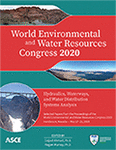World Environmental and Water Resources Congress 2020
Assessing Biological Impacts from Storm Flow Diversions: A Case Study
Publication: World Environmental and Water Resources Congress 2020: Hydraulics, Waterways, and Water Distribution Systems Analysis
ABSTRACT
Herein are described methods and results of analysis of impacts on biological resources in the Upper Arroyo Seco that may result from storm flow diversions associated with the implementation of the proposed Pasadena Water and Power (PWP) Arroyo Seco Canyon Project (ASCP). The ASCP would repair, replace, and/or rehabilitate the diversion and intake structures in the Arroyo to maximize the capture of PWP’s surface water rights. Two-dimensional hydraulic models were prepared of the Devil’s Gate Reservoir area for representative wet, average, and dry years for the existing and with-diversion scenarios. Hydraulic modeling indicates that only during dry years do with-diversion conditions have expected changes to maximum reservoir pool depth. Within the stream section of the study area modeling showed little or no measurable change in hydraulic conditions (i.e. depth, velocity, inundation area, and shear) with project diversions. Additional sediment transport modeling and groundwater analysis indicated no impacts from proposed conditions. An ecological modeling study was prepared for the study area. The ecological effects of flow diversions were assessed based on modeled relationships between proposed hydraulic changes and the probability that the resultant physical conditions can support southern willow riparian habitat conditions conducive to occupancy by least Bell’s vireo. A statistical approach, rather than a mechanistic approach, was used to estimate the probability of occurrence of vireo under physical conditions associated with flow diversion scenarios. All hydraulic variables tested showed significant statistical differences (p<0.001) in willow occurrence between predicted future conditions and historic flow characteristics. Given the small sample size of vegetation polygons and the high number of hydraulic observations, it is believed the significance estimates may be overestimated. The models predict a slight decrease in probability of occurrence of willow habitat in dry years in the proposed condition. However, net changes in probability are less than 10%.
Get full access to this article
View all available purchase options and get full access to this chapter.
REFERENCES
American Ornithologists’ Union (AOU) (1998) Checklist of North American Birds (7th edition). Shipman, VA: Buteo Books.
Barnes, H. H. (1967) Roughness characteristics of natural channels. Geological Survey water supply paper. United States Government Printing Office, Washington.
Bush, D. E., N. L. Ingraham, and S. D. Smith (1992) Water uptake in woody riparian phreatophytes of the southwestern United States: A stable isotope study. Ecological Applications 2:450–459.
Chambers Group Inc (Chambers) (2010) Biological Technical Report for the Devil’s Gate Reservoir Project Site in the City of Pasadena, Los Angeles County, California. Technical Report prepared for the Los Angeles County Department of Public Works. Redlands, CA: Chambers Group, Inc.
Chow, V. T. (1959) Open channel hydraulics. McGraw Hill.
eBird (2018) (September 11). eBird: An online database of bird distribution and abundance [web application]. Ithaca, NY: eBird. http://www.ebird.org.
Franzreb, K.E. (1989) Ecology and Conservation of the Endangered Least Bell’s Vireo (Biological Report 89[1]). Sacramento, CA: USFWS, Endangered Species Office.
Gao, X., X-Y. Chen, T. W. Biggs, and H-X. Yao (2018) Separating wet and dry years to improve calibration of SWAT in Barrett Watershed, Southern California. Water, 10, 274.
Garrett, K. and J. Dunn (1981) Birds of Southern California: Status and Distribution. Los Angeles, CA: Los Angeles Audubon Society.
Goldwasser, S. (1981) Habitat Requirements of the Least Bell’s Vireo (Final Report, Job IV-38.1). Sacramento, CA: CDFG.
Hatch, Charles R. (2007) Trees of the California Landscape. University of California Press: Berkeley, CA.
Lichvar, R. and J. Kartesz. (2009) North American Digital Flora: National Wetland Plant List (version 2.4.0). Hanover, NH: U.S. Army Corps of Engineers, Engineer Research and Development Center, Cold Regions Research and Engineering Laboratory, and Chapel Hill, NC: BONAP.
Los Angeles County Department of Public Works (LACDPW). 2018 (September, access date). Devil’s Gate Reservoir Sediment Removal and Management Project: Resources. CEQA Documents, Historic Resources, Interim Measures Project. Alhambra, CA: Public Works.
National Aeronautics and Space Administration (NASA) (2003) JPL groundwater modeling report, Jet Propulsion Laboratory superfund site, Pasadena, CA. December.
Phillip Williams and Associates (PWA) (2000) Flood hazard, sediment management and water feature analysis, Hahamonga Watershed Park, Pasadena, CA. January 17.
Psomas (2018) Arroyo Seco Canyon Diversions Biological Impacts Memorandum. Technical memorandum for the City of Pasadena Department of Water and Power (November 2018)
Salata, L.R. (1983) Status of the Least Bell’s Vireo on Camp Pendleton, California: Report on Research Done in 1983. Laguna Niguel, CA: USFWS.
Stromberg, J. (2013) Root patterns and hydrogeomorphic niches of riparian plants in the American Southwest. Journal of Arid Environments 94 (2013) 1-9.
Tallent-Halsell, Nita G. and Lawrence R. Walker. 2002. Responses of Salix gooddingii and Tamarix ramosissima to flooding. Wetlands. 22: (4)776-785.
U.S. Fish and Wildlife Service (1994) (February 2). Endangered and Threatened Wildlife and Plants; Designation of Critical Habitat for the Least Bell’s Vireo. Federal Register 59 (22): 4845–4867. Washington, D.C.: USFWS.
Waanan, A.O. and J.R. Crippen (1977) Magnitude and frequency of floods in California. B6 U.S. Geologic Survey Water-Resources Investigation 77-21.
Information & Authors
Information
Published In
World Environmental and Water Resources Congress 2020: Hydraulics, Waterways, and Water Distribution Systems Analysis
Pages: 52 - 64
Editors: Sajjad Ahmad, Ph.D., and Regan Murray, Ph.D.
ISBN (Online): 978-0-7844-8297-1
Copyright
© 2020 American Society of Civil Engineers.
History
Published online: May 14, 2020
Published in print: May 14, 2020
Authors
Metrics & Citations
Metrics
Citations
Download citation
If you have the appropriate software installed, you can download article citation data to the citation manager of your choice. Simply select your manager software from the list below and click Download.
